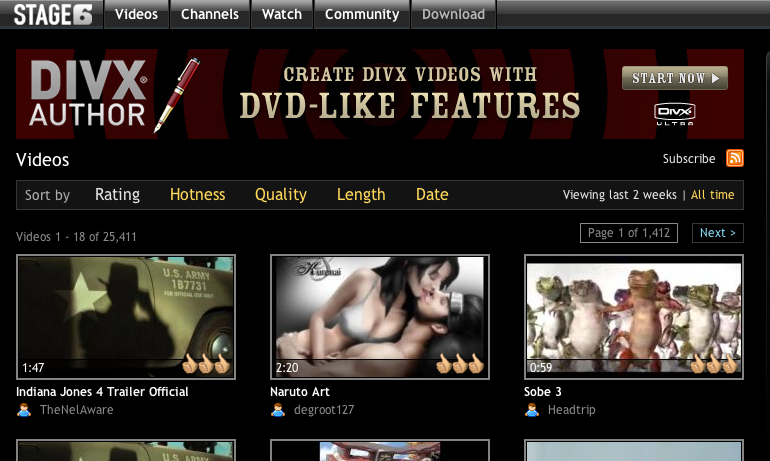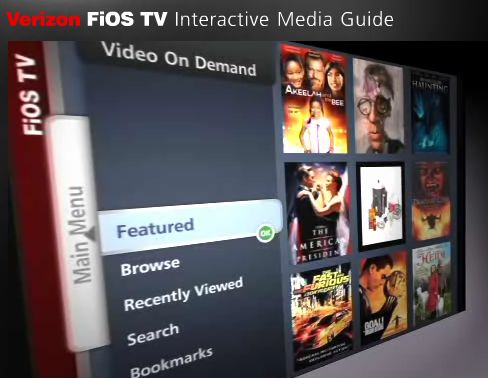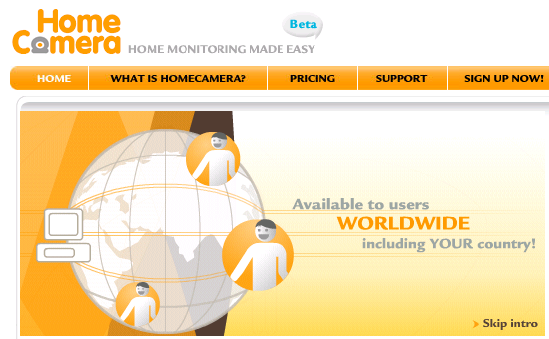Well we’re clearly in the bubble burst of online-video sites. Stage6 shut down, and Revver was sold. Who’s next?

Well we’re clearly in the bubble burst of online-video sites. Stage6 shut down, and Revver was sold. Who’s next?

 You’re running a brand that is trying to “dip your toe” into social media and online video, and you’re facing some important questions:
You’re running a brand that is trying to “dip your toe” into social media and online video, and you’re facing some important questions:
Here’s a quick guide that encompasses a lot of topics we’ve covered on this blog. It’s the “least a marketer or agency needs to know” about online video, and will give you a roadmap for a good program.
With a few exceptions, I haven’t yet seen many online-video pilots driving significant, immediate sales for a brand. But I have seen online-video initiatives that have increased the awareness of the brand, and changed the attributes and preference of target consumers (as measured by awareness trackers). Most of my clients have enjoyed an online presence they wouldn’t have gotten on their own and found it a good investment. A few have confided that more people watched my stupid video than visited their big, bloated agency-developed website (which contained a variety of expensive videos they produced). It’s much easier to reach people on the highway of YouTube than to hope they’ll stop at the little rest stop you create (which is usually a huge expense and a “throw away” at the end of the project).
Other suggestions? Bring ’em on. This is a blog, for crying out loud.
 This is the year where viral video will, no doubt, shape the election. And while this blog cannot possibly keep up on the political satire that’s overtaking YouTube, this one felt worth a mention.
This is the year where viral video will, no doubt, shape the election. And while this blog cannot possibly keep up on the political satire that’s overtaking YouTube, this one felt worth a mention.
Barack Obama’s speech inspired this music video featuring Black Eyed Peas. It’s called “Yes We Can.”
That spawned Election08 (comedians in LA) to produce a music video called “John He Is.” And here’s another parody by BarelyPolitical called “John McCain: No You Can’t.”
Candidly, I’m laughing more at the amazingly simple video by BarelyPolitical that features John McCain prank calling Hillary Clinton with a burp and a fart. Now that’s political humor for the common denominator.
Marketing Consultant Toby Bloomberg (Marketing Diva Blog) is hosting a radio/podcast show on the topic of YouTube as a marketing channel. It’s live tomorrow night (Tuesday, 6:30 PM EST). I’ll be a guest along with Ben Relles, creator of the wildly viral “I Got a Crush on Obama” and Barely Political.
Here are the details:
 I’m going out on a limb here, but I predict that independent web-to-tv boxes will be (albiet perhaps temporary) an inevitable part of the pending collision between our television sets and Internet. We’re past that debate about whether TV or online-video will prevail. There will be a hybrid model, and quite frankly I can’t wait to consume my online-videos with the ease of TiVo surfing. I just don’t watch television anymore and the cable and telcom providers have made that an easy withdrawal.
I’m going out on a limb here, but I predict that independent web-to-tv boxes will be (albiet perhaps temporary) an inevitable part of the pending collision between our television sets and Internet. We’re past that debate about whether TV or online-video will prevail. There will be a hybrid model, and quite frankly I can’t wait to consume my online-videos with the ease of TiVo surfing. I just don’t watch television anymore and the cable and telcom providers have made that an easy withdrawal.
Months ago, I would have bet that cable and telcom monoliths could successfully dominate this space with their own connectivity, equipment, and customer base. But Verizon’s latest release of its Fios TV video interface has convinced me of otherwise. It’s rather hopeless, and we should expect nothing more.
Despite continued investments by cable (Comcast) and telcom (Verizon) providers — which includes fiber and expensive capital — they’re going to be dissintermediated in the short term. Sure they’re winning customers with competitive bundled deals for cable, phone and television. And they have a built advantage because we want a turnkey solution and it’s hard to bypass them unless you want a satellite. But they’re big, slow, and focused more on securing their market position than innovating.
 While the bundling (phone, TV and internet access) is quite economically tempting, the television ‘user experience’ is what real-estate agents call functional obsolescence– it’s a deal breaker. For the past year I’ve suffered through Verizon’s slow, counter-intuitive, buggy and frustrating television interface and would have canceled long ago but for my wife and kids’ desire to watch news and children shows. A few weeks ago, Verizon rolled out an entirely new interface, which is prettier but almost as convoluted. Comcast, last I checked, wasn’t much better. I miss my delightful, buttery TiVo experience, and have two TiVo units depreciating because I can’t figure out how to get them to play nicely with the Fios-mandated Motorolas. And I’m not willing or able to pay a third recurring fee: a TiVo service fee, in addition to my monthly TV bill and rental equipment toll. If only I could just dump the Motorola and pay Fios a cable fee alone.
While the bundling (phone, TV and internet access) is quite economically tempting, the television ‘user experience’ is what real-estate agents call functional obsolescence– it’s a deal breaker. For the past year I’ve suffered through Verizon’s slow, counter-intuitive, buggy and frustrating television interface and would have canceled long ago but for my wife and kids’ desire to watch news and children shows. A few weeks ago, Verizon rolled out an entirely new interface, which is prettier but almost as convoluted. Comcast, last I checked, wasn’t much better. I miss my delightful, buttery TiVo experience, and have two TiVo units depreciating because I can’t figure out how to get them to play nicely with the Fios-mandated Motorolas. And I’m not willing or able to pay a third recurring fee: a TiVo service fee, in addition to my monthly TV bill and rental equipment toll. If only I could just dump the Motorola and pay Fios a cable fee alone.
You see, Fios TV forces me to rent a Motorola media box (actually, I could rent a digital converter, but that doesn’t cost much less per month). I rent two of these stupid units (living room and bed room) and they communicate with each other like Hollywood stars in their 3rd month of marriage.
I expect a cable bill. But a monthly “rental toll” for a mandated unit is reminiscent of Ma-Bell charging $5 a month to my grandparents for a “model T”-like rotary phone (which everyone seems to overlook until the parents die, someone has to clean up the estate, and the children discover they’ve paid thousands in years of renting a phone that could have cost $2.99 at Walmart).
 Meanwhile, I almost tossed my AppleTV months ago, but have recently been spending a lot more time using it. It cost about $300, there’s no recurring fee, and the interface is getting better. I can enjoy any video I download or import as an MP4 (and my handy VisualHub takes care of the conversions for videos I download elsewhere). More importantly, it’s how I’m beginning to consume a lot of my YouTube videos.
Meanwhile, I almost tossed my AppleTV months ago, but have recently been spending a lot more time using it. It cost about $300, there’s no recurring fee, and the interface is getting better. I can enjoy any video I download or import as an MP4 (and my handy VisualHub takes care of the conversions for videos I download elsewhere). More importantly, it’s how I’m beginning to consume a lot of my YouTube videos.
On the negative side, iTunes has its share of limitations: a paltry video-purchase selection via the iTunes store, a ridiculous rental service I won’t soon use again (after a “Live Free or Die Hard” expired before I ever started watching it), and this baffling confusion of trying to synch media across various iPods and Mac accounts.
And frankly, I’m quite sick of being deprived by Mac of sharing or viewing my purchased videos and movies– legally, across my own digitalia.
 That makes me so angry, I’ve starting to resort to getting movies via other mischievous means. Last night I even fell for a Google text ad that boasted a $35 one-time “free movie downloads for life” scam. For my impossible-to-refund fee, I received a special log-in website, password and instructions… which basically provided me a link to LimeWire (a free p2p tool). Caveat emptor I suppose. I was reminded of when, at the age of 9, I bought a “remote-control ghost: flies as high as 100 feet” from a comic book ad. Eight weeks later I received a white plastic bag, a balloon, and 100 feet of string. Even Sea Monkeys and the Ant Farm were better deals.
That makes me so angry, I’ve starting to resort to getting movies via other mischievous means. Last night I even fell for a Google text ad that boasted a $35 one-time “free movie downloads for life” scam. For my impossible-to-refund fee, I received a special log-in website, password and instructions… which basically provided me a link to LimeWire (a free p2p tool). Caveat emptor I suppose. I was reminded of when, at the age of 9, I bought a “remote-control ghost: flies as high as 100 feet” from a comic book ad. Eight weeks later I received a white plastic bag, a balloon, and 100 feet of string. Even Sea Monkeys and the Ant Farm were better deals.
But something promising occurred quietly in the past week. AppleTV pushed out an upgrade, and now my YouTube viewing is slightly closer to the experience of watching videos via YouTube.com directly.
Initially, YouTube viewing via AppleTV provided a fraction of the experience permitted on YouTube. I couldn’t even look at my subscriptions or sort recent videos by creator. This limited YouTube interface is part of the reason I dumped my iPhone after two weeks (AT&T’s poor connectivity was another reason). But now I can at least go beyond watching the top YouTube videos of the day. I can view a random subset of my subscriptions (for odd reasons, they only let me peer into my first dozen or so, which is a bit constraining when you’ve subscribed to 800 people).
If you’re not a YouTube addict, the AppleTV makes less sense, and Apple won’t soon penetrate the market with these units unless they improve the interface further, renegotiate failed content deals and partner with electronic manufacturers or bring down the unit price.
So what’s ahead in 2008?
 Online-video creators are sobering up after an intoxicated 2007, as they realize that the “road to riches” via online video is fraught with challenges. Business Week proclaimed “amateur video hour” as over in December. Crackle and other sites migrated from UGC (user-generated content) some time ago. And here are some quite recent data points that, alone, aren’t really newsworthy but tell a sad story together:
Online-video creators are sobering up after an intoxicated 2007, as they realize that the “road to riches” via online video is fraught with challenges. Business Week proclaimed “amateur video hour” as over in December. Crackle and other sites migrated from UGC (user-generated content) some time ago. And here are some quite recent data points that, alone, aren’t really newsworthy but tell a sad story together:
For sure, some creators are doing well with sponsored gigs, DVD sales and rare television contracts. I’ve managed to augment my income by creating sponsored videos, and have done fairly well in the past 6 months. But it’s certainly not enough to quit the day job, and I’m not patient or risky enough to hold my breath for a lucrative television contract.
Solution 1: Pay for Content?
 With few exceptions, viewers don’t yet pay for amateur content. This is especially true for early adopters of online-video, who have enjoyed free video, including amateur stuff, copyrighted material via YouTube, and free movies & music via P2P sharing. As the mainstream audience moves in, the market for paid content will increase, but mostly for professionally produced and well marketed video. Perhaps we’ll see a third-party aggregate some second-tier amateur content and develop a paid subscription model (especially if that content can be fed into PC, mobile and television). However an individual amateur would inarguably lose the vast majority of their audience if they required the audience to even move to an alternative channel (their own ad-supported site) or charged for it. Even Howard Stern lost most of his audience when he moved to Syrius. So it’s no surprise that I’ve sold only four copies of the “Best of Nalts” DVD.
With few exceptions, viewers don’t yet pay for amateur content. This is especially true for early adopters of online-video, who have enjoyed free video, including amateur stuff, copyrighted material via YouTube, and free movies & music via P2P sharing. As the mainstream audience moves in, the market for paid content will increase, but mostly for professionally produced and well marketed video. Perhaps we’ll see a third-party aggregate some second-tier amateur content and develop a paid subscription model (especially if that content can be fed into PC, mobile and television). However an individual amateur would inarguably lose the vast majority of their audience if they required the audience to even move to an alternative channel (their own ad-supported site) or charged for it. Even Howard Stern lost most of his audience when he moved to Syrius. So it’s no surprise that I’ve sold only four copies of the “Best of Nalts” DVD.
Solution 2: Ad-Supported Content
 As much hype as we’ve seen about consumers avoiding ads, this is the most viable, sustainable model. Simply put, good content won’t sustain for free, and amateur content hasn’t a prayer unless it’s supported by ads. Currently, this model is rate-limited by two sad realities. First, advertisers have been slow to buy ads around amateur content — even YouTube doesn’t appear to be selling its full inventory of InVid (overlay) ads. Secondly, there’s not yet broad enough distribution of this content.
As much hype as we’ve seen about consumers avoiding ads, this is the most viable, sustainable model. Simply put, good content won’t sustain for free, and amateur content hasn’t a prayer unless it’s supported by ads. Currently, this model is rate-limited by two sad realities. First, advertisers have been slow to buy ads around amateur content — even YouTube doesn’t appear to be selling its full inventory of InVid (overlay) ads. Secondly, there’s not yet broad enough distribution of this content.
I’ll argue that good video content and consumer demand exists, but people there aren’t yet enough viewers of amateur content to warrant significant dollars from advertisers. And we’re in dire need of an easy vehicle to view UCG via our mobile and television boxes, which will increase both viewer demand and advertising inventory (my next post will explore web/TV devices, which I believe are the lynch pin here).
![]() The more we surf online video the more savvy we become about content versus advertising.
The more we surf online video the more savvy we become about content versus advertising.
A marketer recently told me he was pleased by the impressions he got from a YouTube homepage advertising buy, but…” I finished his sentence for him.. “your featured video didn’t get a lot of views.”
I told him we’ve been trained that the YouTube featured video is an advertisement, and he said he was working on ways to produce a more provocative headline or thumbnail. This “learned ad blindness” (I just coined that) was true with Revver ads, where virgin viewers would click the end-frame ad out of curiosity while the regulars learned to move to the next video. Revver is now adopting overlays jam packed with what appears to be Google Adsense Ads. Meanwhile, Adsense itself is under performing. Jason Lee Miller of WebProNews wrote recently about performance declines of Google Adsense, and one of his theories is:
“People are ignoring ads at a higher rate, and this has been evidenced by eye-tracking studies, especially when the ads appear in the places they expect them to appear.” (Note: to reinforce Miller’s point, I’ve displayed an image tracker of where eyes go when viewing a Google search-results page… hot in the top of organic area and rather cold on the ads).
So what’s the solution? Is it constant rotation of ads so they masquerade as content or perpetually innovative ways to interrupt, arouse or tantelize? YouTube’s “videos being watched right now” is a combination of sponsored videos and popular ones. They’ve changed the name of this section several times, but I believe it remains an advertorial blend.
 That’s not the answer long term. Your most trusted sources of media (television, print, radio, web) usually make it abundantly clear what’s an advertisement and what’s content. Google pioneered this delineation by giving a color to ads while some engines continue to advantage advertisers in the “organic” listings with something called “paid inclusion” that creeps me out. The “advertorial” game, where advertisers sponsor what appears to be objective articles, is for the bottom feeders.
That’s not the answer long term. Your most trusted sources of media (television, print, radio, web) usually make it abundantly clear what’s an advertisement and what’s content. Google pioneered this delineation by giving a color to ads while some engines continue to advantage advertisers in the “organic” listings with something called “paid inclusion” that creeps me out. The “advertorial” game, where advertisers sponsor what appears to be objective articles, is for the bottom feeders.
My first job after college was for a small Georgetown newspaper where the editor literally put a small white fence between the editorial and advertising department. I proudly stood on the content side, and the newspaper went bankrupt in 9 months. It was what prompted me to attend business school and move to the marketing side. I’d need to shower more frequently, but I’d at least have some control of my destiny.
The solution to “learned ad blindness” (copyright Kevin Nalts) is making ads that appeal to viewers and targeting people based on relevancy. If I’m in the market for a car, I want your car ad. If I’m not, it better have dancing clowns, hot models and site gags. If watching videos about the new overpriced talking parrot toy in late November, I’m probably ready for a 20% Toys-R-Us ad. See my next post (Cherry Chocolate Rain) for an even better example of when advertising does indeed become content.
Initially advertisers were terrified by technology that would block ads — from FireFox plugins to TiVo remotes. I’d content the greater barrier is the technology of the human mind, which learns quickly to discriminate between valued content and noise.
Like my old boss used to say, “even an amoeba learns by repetition.”
 The nice thing about moderately promoted online-video contest is that your odds are really good.
The nice thing about moderately promoted online-video contest is that your odds are really good.
HomeCamera.com (a free home surveillance system) asked if I’d do a sponsored video. I offered instead to promote a contest if they’d give out some of the D-Link wireless cameras (see image below) that are being sold with HomeCamera preconfigured. They sent me a demo unit and I was impressed, since it’s not easy to do this with your webcam on your own.  The service is free now, and allows you to monitor your home from almost any device worldwide. I’m going to be interested to see how people tackle this video contest (see here for details). What would you do with HomeCamera? Spy on your kids? Track your home or pet? Check in on an aging parent?
The service is free now, and allows you to monitor your home from almost any device worldwide. I’m going to be interested to see how people tackle this video contest (see here for details). What would you do with HomeCamera? Spy on your kids? Track your home or pet? Check in on an aging parent?
So here’s my YouTube video promoting the HomeCamera contest, which runs through March 1. I’m not a judge, so – hey- I wonder if I can enter? Again- decent odds of winning a D-Link, and the grand prize is a flight to Singapore. Oh- and accommodations included for up to 4 nights. They’ll even toss in a return flight.

Marketers debate whether they should engage in online video, but there’s simply no excuse for not paying attention to what’s being said about your brand. There are good services that can do comprehensive audits (such as Buzzmetrics). But here’s the poor-man’s solution…
Subscribe to your brand’s name on YouTube. If you’re Coke and you’re not at least scanning videos that are tagged with the word Coke, then you may miss something important. It’s as simple as registering on YouTube and going to your subscriptions. Then enter your brand name in the “tag” section, and you’ll have videos waiting for you if they use your name in the tags.
There are other services doing more comprehensive, advanced and ongoing monitoring by turning speech into text, and then analyzing the content in sophisticated ways. But this is a nice place to start. It’s as easy as setting a “Google Alert” for your brand name to ensure that news and major blog posts aren’t missed.
 Oh it’s so rare when someone writes an intelligent article about online video (aka viral) marketing. And it’s pretty funny when you’ve never heard of the author but she happens to work for the digital agency you employ in your day job.
Oh it’s so rare when someone writes an intelligent article about online video (aka viral) marketing. And it’s pretty funny when you’ve never heard of the author but she happens to work for the digital agency you employ in your day job.
Anyway, here’s “Strategies for Making Video Ads Go Viral,” by Christine Beardsell (Digitas) via ClickZ. Christine explains paid and organic “seeding” of videos, which is not very well understood. She references two companies I hadn’t heard about: Kontraband’s The 7th Chamber and Viral Manage, which apparently seed videos, and offer tiered plans that include viral tracking and blog/forum seeding.
She also observes that a little money can go a long way with smaller video sites, and I’ve also found that to be true. I once got a promotional video past one million views by throwing a modest media buy to a second-tier site for some premium placement.
I’m not sure I agree that online video banners aren’t effective. In general, it’s true that banners are ignored. And auto-play banners are repulsively annoying. But I do believe there’s a role for embedded video in interactive, rich media ads. I found her thoughts about RSS and videos interesting, but caution people from thinking too many people will RSS for commercial videos. Get a well known YouTuber to mention your brand and you’ll get exponentially more visibility for far less money than your agency will charge for a FedEx.